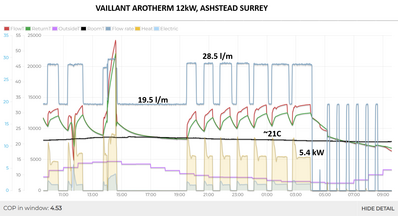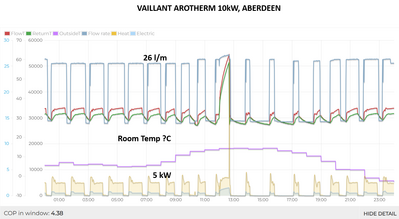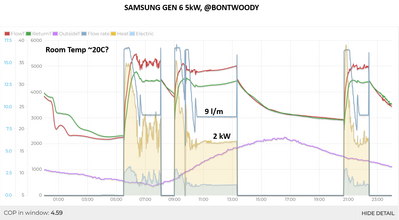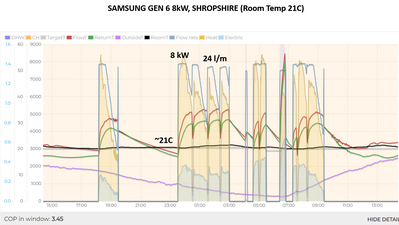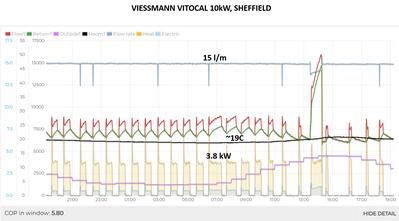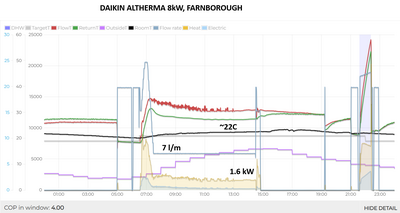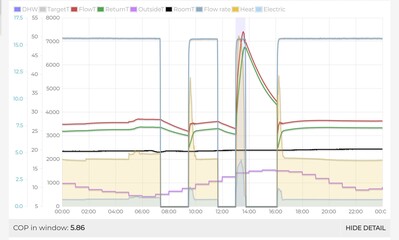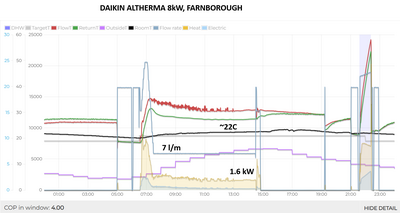Performance of Heat Pumps in Mild Weather
For those that may be interested, I am attaching graphs of the performance of different heat pumps during milder weather as it gives an indication of their cycling behaviour.
1. 12kW Vallaint HP in Surrey, a top performer. This is characterised by a fixed high water flow which switches on and off in cycles. In this case the flow has been turned down by the user to 28 l/min to provide a maximum output <10kW. Minimum power is around 5kW with DT very low.
2. 10kW Vaillant with fixed flow set at maximum output. This exhibits similar cycling behaviour to the previous one with minimum power 5kW, although the target room temperature is not known. DT is again very low.
3. 5kW Samsung Gen 6 of @bontwoody. This exhibits more stable behaviour without much cycling. Flow has been modulated down by the HP from the maximum of 14 l/m to 7l/m providing minimum output of 2kW with DT around 3.3C. Instead of modulating the flow, the HP sets a fixed flow of 9 l/m, down from the max of 14 l/m, and modulates the DT which is contrary to the normal belief that it maintains a steady 5C DT and modulates the flow. It may be that the minimum flow is set above the 7 l/m flow switch cutoff so that it can provide a lower power output. Interestingly, the Samsung outperforms Vaillant on COP. Another characteristic of the Samsung is a high turn-on power which is sustained for a period before turning down to 2kW. This ramps up temperature faster but the downside consequence of this is seen in the next example.
4. 8kW Samsung Gen 6 in Shropshire. The consequence of rapid cycling with the Samsung is seen here. At each initiation, there is high power output which merges and destroys COP. This shows the way not to do things. It is not known why the off cycle is so short, but the consequence is terrible.
5. 10kW Viessmann Vitocal in Sheffield which is the best performing UK heat pump, largely due to the fact that room temperature is maintained at 18-19C, which flatters on COP. The unit cycles regularly but, unlike the Samsung it has a very short heat spike before settling on a minimum power of 3.8kW with a relatively low DT of 3.3C. The HP maintains a constant flow at 15 l/m, which is modulated down from the maximum of 28 l/min (5C DT).
6. 8kW Daikin Altherma in Farnborough. Like the Samsung, it has a short period of high power output before modulating flow down to 7 l/min from max of 24 l/m with a steady minimum power output of 1.6kW with DT 3.5 to 5C without cycling. This has the most stable performance with the lowest minimum power output. Counterintuitively, the COP does not reflect this performance but may be somehow due to the very high room temperature of 22-23C, even though this should not affect COP. I have not tried to analyse this. However, maybe this makes a case for a thermostat to maintain a reasonable room temperature which would improve heating bill, rather than an overheating clamp.
Private individual. No affiliation with commercial "Heat Geeks" of same coincidental name.
This is quite interesting as my system cycles a lot and we have a flow rate of around 28l/min and this is on medium pump setting. We usually have a low DT, I have it set to constant night mode to stop it using stupid amounts of energy and this seems to be working. I wonder if I reduce the pump to it’s lowest setting it will help with the cycling or if I should ramp it up again and get higher flow rates. The learning curve is steep with ASHPs!
Kind Regards
Si
——————————————————————————
Grant Aerona3 13kW
13 x 435w + 13x 480w Solar Panels
Sigenergy 10kW Inverter
16kW Sigenstor battery
@grantmethestrength Do you know what your DT was when you were heating at -2C outside? This will give an indication of what your peak heat load was. Grant are unusual for a heat pump manufacturer as they specify that the peak DT should be set at 8C as the flow is fixed. You can calculate your heat load with the following formula:
Power kW = Flow(l/m)/60 x DT x 4.2
For 13 kW power and 28 l/m, your max DT would be 6.6C. For 8C DT, the flow would be 23 l/m assuming that you can use all the 13kW power at -2C. If your heat pump is over-sized, then the flow should be even lower. Grant state that this is how a system should be set up to match the power output required. Bear in mind though that your minimum flow is 15 l/min. The reason for the 8C is because the flow is fixed and as days get warmer, the DT of the HP will decrease to ensure reduced power. The 8C avoids too low a DT at low power for example. IMHO Vaillant users should also adopt this policy but no one hears.
To understand the effects, look at the example of a Grant Aerona I have given which is not performing too well. At just 5C OAT, the DT is 1.6C with flow of 34 l/m. If you do the math you will see that the power output of 3.8kW matches. 1.6C is way too low. When cycling there are big power peaks and short operation times – not good for COP as the results show. So in this case the flow needs to come down to widen the DT. It looks over-sized. They are also not using weather compensation as the flow temperature is constant which makes matters even worse. Too much heat output on warm days causing short cycling.
I don’t know your circumstances but you can do the math. My gut feel tells me that you need to reduce the flow further as per the above calculations. Your DT at lowest outdoor temperature will give you the best indicator according to Grant recommendations. Besides the pump setting, you can also adjust flow on the flow meter. Hope this helps.
Private individual. No affiliation with commercial "Heat Geeks" of same coincidental name.
Posted by: @heatgeek3. 5kW Samsung Gen 6 of @bontwoody.
...
Interestingly, the Samsung outperforms Vaillant on COP.
As both Vaillants do DHW but the Samsung doesn't, you'd expect the daily mean COP of the Vaillants to be less. Also the first Vaillant does a defrost cycle demonstrating that the environmental conditions weren't the same.
An example of constant running with a low dT without a very low (7-9 lpm) flow rate:
This is a Mitsubishi BTW.
@heatgeek thanks for the info I will look into this, unfortunately I don’t have accurate data from last winter as we only had the pump installed in Jan. with this info I will be much better prepared for next winter. I think I will start by switching the pump to it’s lowest setting and then tweaking the screw on the flow meter.
Thanks!
Kind Regards
Si
——————————————————————————
Grant Aerona3 13kW
13 x 435w + 13x 480w Solar Panels
Sigenergy 10kW Inverter
16kW Sigenstor battery
@robs Thank you for this. I had forgotten about Ecodan, especially as I have one with its dangly NTC leads. I presume the example is a 5kW unit. This diagram doesn’t prove anything. At just over 15 l/min with DT of 2, the power would be 2kW which validates the diagram. As the room temperature doesn’t vary, what is controlling the cycling – a thermostat? If so, at least it shows that controlled intermittency saves energy instead of continuous working. In my book, the diagram shows that the power is well matched to the heat load without cycling, hence the good COP. If you drop an equivalent Vaillant in its place you will get the same result. You seem to be hooked up on low DT being good. IMHO a low or high DT or flow does not affect COP at all as long as the heat is carried away efficiently from the PHE. The issue here is the RANGE of DT available from a heat pump (with a fixed flow setting) to transport the variable heat power without cycling. DT is not set by the HP. It is a result of the emitters’ behaviour which the HP has to adjust to.
According to the Grant principle outlined previously, they advocate setting a DT of 8C at peak output, provided the HP is reasonably well matched to the peak load of the building. This therefore provides a range of 8C to 2C on fixed flow i.e. variation down to ¼ of peak output. If you have a set room temperature of 21C, the room DT with -3C OAT is 24C. At 15C OAT, DT is 6C, i.e. ¼ of peak load. Therefore approx. full range will be available from the HP without cycling. Compare that to starting with an over-sized HP with initial 4C DT which only has a 2C DT before cycling.
I am not trying to establish a hierarchy of heat pumps or to defend a particular brand’s reputation. All heat pumps can produce full output at low OAT. I am trying to understand how different heat pumps behave at the other end of the OAT temperature scale and what techniques are used. As far as Samsung is concerned, some people denigrate it vis a vis European models. This at least shows that it can perform on a par with others if set up correctly. I take the point about DHW, but one DHW cycle doesn’t collapse the COP.
In summary, low DT has nothing to do with the price of eggs, unless you are in the USA.😊
Private individual. No affiliation with commercial "Heat Geeks" of same coincidental name.
@heatgeek I have a very over-sized Samsung (12kW gen6, with a heat loss of maybe 4-5kW). We suffer with poor dT which struggles to get above 3C. Are you saying we should try to reduce flow rate? We currently run a fixed flow of 24L/min (no PWM pumps), but I can reduce further to ~21L/min.
In winter when OAT drops to around 5C or below, we can run continuously with a flow temp of 30-32C, but above that I just use a room thermostat to control ON/OFF to prevent any short cycling (the 0.5C hysteresis gives us decent 40-60min cycles). During milder weather, it's more like running a conventional gas/oil boiler as the minimum flow temps we can achieve (to allow our radiators to emit the heat generated) is ~33C, which means the house is up to temp in an hour and the heating goes off for the rest of the day.
Our COPs seem pretty good, but always keen to maximise that last little bit of efficiency.
Where I'm struggling to understand is reducing flow rates increases dT, but a larger dT means higher flow temps to achieve the same room to radiator dT? And I'm assuming running a higher flow temp for the same room heat output is less efficient?
Samsung 12kW gen6 ASHP with 50L volumiser and all new large radiators. 7.2kWp solar (south facing), Tesla PW3 (13.5kW)
Solar generation completely offsets ASHP usage annually. We no longer burn ~1600L of kerosene annually.
@heatgeak It's good to talk about mild temperatures and heat pumps, they don't get discussed very often.
Posted by: @heatgeek@robs Thank you for this. I had forgotten about Ecodan, especially as I have one with its dangly NTC leads. I presume the example is a 5kW unit. This diagram doesn’t prove anything.
It's a 8kW unit. It does prove that there is an alternative to the Samsung or Daikin at 7-9 lpm, and Valiant at 25+ lpm.
Posted by: @heatgeekAt just over 15 l/min with DT of 2, the power would be 2kW which validates the diagram. As the room temperature doesn’t vary, what is controlling the cycling – a thermostat?
Just weather compensation and the wireless thermostat acting as a IAT based limiter.
Posted by: @heatgeekIf so, at least it shows that controlled intermittency saves energy instead of continuous working.
Do you mean a set back or Valliant-type energy integral type intermittency? Both compromise IAT to some degree, so it becomes something of an apples vs oranges comparison.
Posted by: @heatgeekYou seem to be hooked up on low DT being good. IMHO a low or high DT or flow does not affect COP at all as long as the heat is carried away efficiently from the PHE. The issue here is the RANGE of DT available from a heat pump (with a fixed flow setting) to transport the variable heat power without cycling. DT is not set by the HP. It is a result of the emitters’ behaviour which the HP has to adjust to.
High or low dT effects the flow temperature needed to achieve the same mean emitter temp, lower is typically better (thermal dynamics at work).
Posted by: @heatgeekAccording to the Grant principle outlined previously, they advocate setting a DT of 8C at peak output, provided the HP is reasonably well matched to the peak load of the building. This therefore provides a range of 8C to 2C on fixed flow i.e. variation down to ¼ of peak output.
But the compressor's range isn't that wide, compressors can usually only do about 1/3 of max. So maybe start with the mild temp dT, say 2C, and then calculate the low/design temp dT using the compressor range? Rather than start with an arbitrary low/design temp dT?
Posted by: @heatgeekIf you have a set room temperature of 21C, the room DT with -3C OAT is 24C. At 15C OAT, DT is 6C, i.e. ¼ of peak load. Therefore approx. full range will be available from the HP without cycling.
No arguments with that, if the compressor can do 1/4 of max then that'll work great!
Posted by: @heatgeekCompare that to starting with an over-sized HP with initial 4C DT which only has a 2C DT before cycling.
If the heat pump is over-sized then dT doesn't really matter as its power output will be too great and it'll have to cycle.
Posted by: @heatgeekAs far as Samsung is concerned, some people denigrate it vis a vis European models. This at least shows that it can perform on a par with others if set up correctly. I take the point about DHW, but one DHW cycle doesn’t collapse the COP.
No argument from me, a well setup Samsung/Daikin/Mitsubishi/etc will outperform a poorly setup Valliant/Viessmann/etc. But with regards to the DHW, if you compare 4.53 (1st Valliant) to 4.59 (1st Samsung) then I'd suggest that the DHW and defrost cycle the Valliant does will make a noticeable difference to its COP.
Posted by: @heatgeekIf you have a set room temperature of 21C, the room DT with -3C OAT is 24C. At 15C OAT, DT is 6C, i.e. ¼ of peak load. Therefore approx. full range will be available from the HP without cycling.
No arguments with that, if the compressor can do 1/4 of max then that'll work great!
I have not yet seen a set of performance curves for a heat pump with more than a factor of 3 between max output (at say OAT - 2C) and min output (at say OAT12C), and I've looked at a lot of curves/tables (most of the ones I can get my hands on in fact). The exception to the is the two-compressor R290 8kW ecodan. The modulation range appears, in practice, currently to be limited by compressor capabilities not the ability to carry the heat away, and thus even a perfectly sized heat pump (except the R290 8kW Ecodan) is going to cycle at OAT 10-12 or above, assuming that the design OAT is -2 or below.
If, @heatgeek , you can point at any performance curves/tables which have better than a factor of 3 between max and min I would be very interested because it would point to superior compressor technology (or a nasty trick).
4kW peak of solar PV since 2011; EV and a 1930s house which has been partially renovated to improve its efficiency. 7kW Vaillant heat pump.
@jamespa Sorry, I should have added the word "theoretically" as I was trying to rationalise the theory behind Grant's 8C philosophy. Whether heat pumps can meet this is a matter of design practicality obviously. However, having said that, perhaps you could assist with rationalising how this 8kW Daikin manages to maintain a steady 1.6kW without cycling according to the graphs, as it has me a bit baffled. Am I misreading something?
.
Private individual. No affiliation with commercial "Heat Geeks" of same coincidental name.
Posted by: @heatgeekHowever, having said that, perhaps you could assist with rationalising how this 8kW Daikin manages to maintain a steady 1.6kW without cycling according to the graphs, as it has me a bit baffled. Am I misreading something?
I cant immediately see you are misreading - although I cant be sure, I can only try to deduce, which lines correspond to which scales. Im presuming you are calculating 1.6kW from 7l/min * DT as there doesn't appear to be a scale that reads 1.6 (correction - maybe the blue scale does?)
Exactly which model is this? Its a while since I looked at Daikin performance curves (they weren't that easy to find or use) but Im pretty sure that the ones I looked at were roughly the same factor of 3 modulation I referred to above.
Maybe this is a newer model/maybe they do have compressor technology superior to others - although its mildly unlikely because, as I understand it, the modulation limits are basically determined by the rate of leakage past the seal, which starts to dominate (and thus limit compression ratio) if you cut the frequency/revs per second too much. Since this is presumably a function of well honed manufacturing tolerances it seems unlikely that anyone will do much better than the herd for any length of time (and if they did they would be trumpeting it)
There is a technology called 'hot gas bypass'. I don't entirely understand it but, to the extent I do, it basically allows some compressed gas to bypass the expansion valve and end up directly in the low pressure side, effectively throwing away' some of the energy (but where to?). Its apparently well known as a method in the compressor world for stabilising output at low demand. Samsung certainly used to use it (there was a 'hot gas bypass valve in their internal plumbing diagrams), I don't know if Daikin do. From the little I understand it seems to be a bit controversial, I guess because (a) there is the appearance of high modulation depth without necessarily delivering the COP benefits (because the compressor is still working at a high compression ratio and rate). That said I don't know what the net effect on COP or longevity or anything else is, so would not pretend to be in a position to 'adjudicate' the controversy.
If you tell me which model this is I will look to see if its one of the ones for which I downloaded data.
Sorry I cant be more helpful, if this is a real 1.6:8 modulation range (over a range of OATs as well) then why aren't they shouting about it and why do they bother with the lower end models (which I am told, possibly incorrectly, are anyway the 8kW model software limited). Im definitely interested to find out more!
4kW peak of solar PV since 2011; EV and a 1930s house which has been partially renovated to improve its efficiency. 7kW Vaillant heat pump.
- 26 Forums
- 2,342 Topics
- 53 K Posts
- 238 Online
- 6,000 Members
Join Us!
Worth Watching
Latest Posts
-

RE: Are We Sleepwalking Into Another Race to the Bottom?
…otherwise known as “hive got news for you”. And don’...
By Majordennisbloodnok , 10 hours ago
-
RE: Configuring third party dongle for Ecodan local control
Logically, I'll fall into that category so the natural ...
By Sheriff Fatman , 11 hours ago
-

RE: Controlling Daikin Altherma via P1P2 and Home Assistant
I haven’t got a Daikin but I have been having some fun ...
By Majordennisbloodnok , 11 hours ago
-

RE: Setback savings - fact or fiction?
@robs — thanks again for your detailed comments. Some r...
By cathodeRay , 13 hours ago
-
RE: Free Ecoheat Heat Pump Install
I don't mind thread drift, it's how conversation natura...
By Deltona , 15 hours ago
-

RE: A Smarter Smart Controller from Homely?
@papahuhu I hope you get a swift resolution. Regards, T...
By Toodles , 17 hours ago
-

RE: Poll for Time of Use, tariffs, technology
That’s fine by me too Major, I feel it is a sad reflect...
By Toodles , 18 hours ago
-

Bingo. Sometimes a judiciously placed size 10 bovver bo...
By Majordennisbloodnok , 19 hours ago
-
RE: Mitsubishi Ecodan 11.2kW heat pump with low COP
@ciocoiu-alexandru I can't provide the same level of di...
By Sheriff Fatman , 19 hours ago
-
RE: Octopus Cosy Heat Pump Owners & Discussion Thread
Recently had my follow up with octopus for the vibratio...
By swwils , 20 hours ago
-

The three technical issues I'm considering are: BMS...
By Transparent , 21 hours ago
-
RE: LiFePO4 lithium battery fires and explosions
@transparent Your post may fit better in th...
By Batpred , 21 hours ago
-

RE: British Gas vs Octopus Energy vs Heat Geek vs EDF vs Aira vs OVO vs EON.Next vs Boxt
@jamespawhite, if you could be bothered, you could also...
By Mars , 23 hours ago
-
RE: Commencing on an ASHP Installation Process
I've got a bit of time to draft something today, so the...
By Sheriff Fatman , 2 days ago
-
RE: Help with heat pump sizing
@amin I dont think materially relative to t...
By JamesPa , 2 days ago
-

@majordennisbloodnok I have decided to take the plunge....
By TechnoGeek , 2 days ago
-
RE: Different dT on each radiator?
I cant sorry. Its based on some calculations I did fro...
By JamesPa , 2 days ago
-
RE: Help me keep the faith with my air source heat pump installation
@simonf thats interesting as I’ve noticed my flow and r...
By AdamK , 3 days ago

